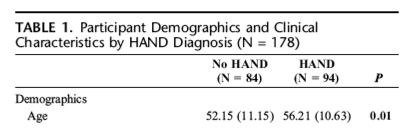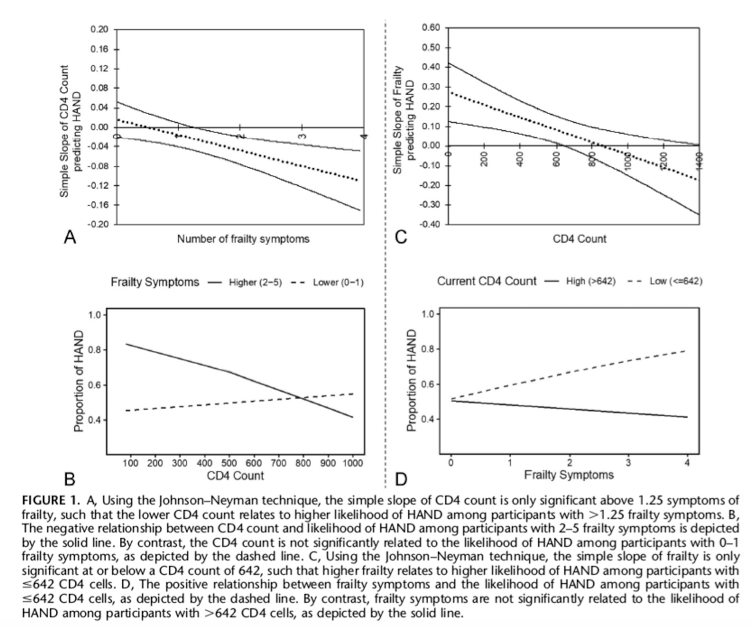| |
Lower CD4 Increased Risk: Frailty and HIV Disease Severity
Synergistically Increase Risk of HIV-Associated Neurocognitive Disorders
|
| |
| |
Download the PDF here
"lower CD4 was associated with increased likelihood of HAND. Inversely, when CD4 was examined as the moderator, the relationship between frailty and HAND became significant at 642 or less cells/mm3, such that higher number of frailty symptoms was associated with increased likelihood of HAND"
Participants were 178 PWH (n = 84 no HAND; n = 94 HAND) enrolled in National Institutes of Health–funded research studies at the UC San Diego's HIV Neurobehavioral Research Program from 2014 to 2019. Average age 52 - 56

PWH also have higher rates of frailty and at younger ages, which further increases vulnerability to poor health-related outcomes.8–12 In fact, greater frailty seems to be linearly associated with worse neurocognitive functioning among PWH.
RESULTS: Participant characteristics are displayed in Table 1. HAND subtypes included 5% HAD (n = 5), 22% mild neurocognitive disorder (n = 21), and 72% asymptomatic neurocognitive impairment (n = 68). Participants with HAND were older (P = 0.01) and had lower estimated premorbid verbal IQs (P < 0.001) than those without HAND. HAND groups were comparable on all other demographic, psychiatric, and HIV disease characteristics (ps > 0.10). HAND groups did not differ on the Fried frailty status or the average number of Fried frailty symptoms; however, participants with HAND were more likely to meet the criteria for slow walking speed compared to those without HAND (P = 0.001). Participants with HAND also had higher rates of diabetes (P = 0.04), hypertension (P < 0.001), and hyperlipidemia (P = 0.04) than those without HAND.
This study investigated the independent and interactive effects of current HIV disease severity (ie, CD4 cell count, plasma HIV RNA viral load) and the number of frailty symptoms on the likelihood of HAND. We found a significant interaction between CD4 and frailty on HAND. When frailty was examined as the moderating variable, the relationship between CD4 and HAND became significant at 1.25 or more symptoms (2 symptoms for clinical relevance), such that lower CD4 was associated with increased likelihood of HAND. Inversely, when CD4 was examined as the moderator, the relationship between frailty and HAND became significant at 642 or less cells/mm3, such that higher number of frailty symptoms was associated with increased likelihood of HAND. The plasma HIV RNA viral load did not associate with HAND or interact with frailty. Participants with HAND also had higher rates of diabetes (P = 0.04), hypertension (P < 0.001), and hyperlipidemia (P = 0.04) than those without HAND.
Results highlight the importance of considering both frailty and CD4 in PWH at risk of neurocognitive impairment. We found that frailty is critical even at low levels. This is consistent with previous research showing that 1 to 2 symptoms of frailty (prefrailty) is associated with neurocognitive impairments among community-dwelling adults20 and is predictive of neurocognitive decline over 2 years among PWH.21 Furthermore, rates of frailty and prefrailty in our sample were consistent with other samples of PWH.22 Our results additionally suggest that frailty, in conjunction with low CD4, can be especially problematic for cognition to the extent of a diagnosable neurocognitive disorder. Interestingly and unexpectedly, CD4 was shown to be important even up to 642 cells/mm3, which is at a level traditionally accepted as within the normal range (500–1500 cells/mm3). Although nadir CD4 has been demonstrated to predict HAND,15 this study uniquely establishes a relationship between current CD4 (interacting with frailty) and HAND, which has significant clinical implications because unlike nadir, current cell count is modifiable.
In summary, our findings support an interaction between frailty and CD4 count on the likelihood of HAND. Clinically, providers may be impactful in mitigating HAND by screening for frailty in the context of relatively lower CD4 counts or more closely follow CD4 counts in the context of 2 or more symptoms of frailty. A CD4 count below 642 cells mm3 should prompt clinicians to assess for frailty, and identification of 2 frailty symptoms in PWH should prompt for closer monitoring of CD4 to identify or possibility mitigate neurocognitive impairment. Future studies examining the moderating effect of frailty on neurodegeneration and HAND would be an important next step to further investigate the role of frailty on HIV disease and cognition.

----------------
HIV-associated neurocognitive disorders (HAND) are also highly prevalent among PWH and are associated with multifactorial detriments to quality of life.7
PWH also have higher rates of frailty and at younger ages, which further increases vulnerability to poor health-related outcomes.8–12 In fact, greater frailty seems to be linearly associated with worse neurocognitive functioning among PWH.13 Whether frailty confers even greater risk of HAND in the presence of other risk factors, however, is unknown. For example, among individuals with Alzheimer disease, frailty has been shown to moderate the relationship between neuropathological disease burden and clinical manifestation of dementia.14 Among PWH, examining a possible interaction between frailty and HIV disease severity on HAND is important for informing the clinical care of aging PWH because these are modifiable risk factors that, if intervened on, could improve the quality of life and prolong health span.
the current study examined the interaction between frailty and markers of current HIV disease severity on likelihood of HAND. We hypothesized that worse HIV disease severity (ie, low CD4 and/or high HIV RNA viral load) would be associated with greater risk of HAND only at higher levels of frailty and vice versa. Importantly, our aims and hypotheses are only concerned with markers of current disease severity (ie, CD4 cell count and HIV RNA viral load) because they are intervenable. Notably, we did not examine antiretroviral therapy (ART) use as a predictor because our sample consisted of very few individuals who were off ART (n = 5). Although low nadir CD4 has been previously established as a predictor of HAND,15 this measure is not modifiable.
RESULTS: Participant characteristics are displayed in Table 1. HAND subtypes included 5% HAD (n = 5), 22% mild neurocognitive disorder (n = 21), and 72% asymptomatic neurocognitive impairment (n = 68). Participants with HAND were older (P = 0.01) and had lower estimated premorbid verbal IQs (P < 0.001) than those without HAND. HAND groups were comparable on all other demographic, psychiatric, and HIV disease characteristics (ps > 0.10). HAND groups did not differ on the Fried frailty status or the average number of Fried frailty symptoms; however, participants with HAND were more likely to meet the criteria for slow walking speed compared to those without HAND (P = 0.001). Participants with HAND also had higher rates of diabetes (P = 0.04), hypertension (P < 0.001), and hyperlipidemia (P = 0.04) than those without HAND.
When examining frailty as the moderator, results revealed that the negative relationship between CD4 and the likelihood of HAND was significant only among participants with frailty greater than 1.25 symptoms (Fig. 1A). That is, among participants with more than 1.25 frailty symptoms, lower CD4 related to higher likelihood of HAND. For clinical interpretability, Figure 1B illustrates simple slopes of the interaction effect at higher (2 or more symptoms) and lower levels of frailty (0 or 1 symptoms). When examining CD4 as the moderator, results showed that the positive relationship between frailty symptoms and the likelihood of HAND was significant only among participants with less than or equal to 642 CD4 cells/mm3 (Fig. 1C). That is, among participants with ≤642 CD4 cells/mm3, a higher number of frailty symptoms related to higher likelihood of HAND (Fig. 1D).
The next logistic regression revealed no significant independent or interactive effects of plasma HIV RNA viral load and number of frailty symptoms on the likelihood of HAND (ps > 0.05).
-------------------------
Brief Report: Frailty and HIV Disease Severity Synergistically Increase Risk of HIV-Associated Neurocognitive Disorders
JAIDS Aug 15 2020
Abstract
Background:
Frailty disproportionally affects people with HIV (PWH) and increased frailty in this already vulnerable population is associated with worse neurocognitive functioning. Whether frailty interacts with current and modifiable markers of HIV disease severity to synergistically increase risk for HIV-associated neurocognitive disorders (HAND), however, is unknown and important for informing the clinical care of aging PWH.
Setting:
UC San Diego's HIV Neurobehavioral Research Program.
Methods:
Participants were 178 PWH evaluated between 2014 and 2019. HIV disease severity was measured by current CD4 count and plasma HIV RNA. HAND diagnoses were made according to the Frascati criteria using a 7-domain neuropsychological battery, and the Fried phenotype criteria were used to assess frailty syndrome (0–5 symptoms). The independent and interactive effects of frailty and current HIV disease severity (ie, CD4 count and plasma HIV RNA) on HAND were examined using multiple logistic regressions.
Results:
There was an interaction between CD4 count and frailty on HAND. Simple slopes showed that CD4 count and the likelihood of HAND were negatively associated at >1.25 symptoms of frailty, and conversely, frailty and HAND were negatively associated at 642 or less cells/mm3. There were no significant independent or interactive effects of plasma HIV RNA and frailty on the likelihood of HAND.
Conclusions:
In addition to monitoring CD4 count, assessing for frailty may be critical in older adults with HIV to potentially mitigate poor neurobehavioral outcomes. Longitudinal follow-up studies are needed to determine the directionality of these findings.
|
|
| |
| |
|
|
|